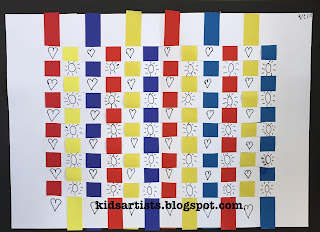Golden Gate Bridge, made by Elize, grade 6
You need:
- grey paper A4 size
- white and black pencils
- pictures of famous skylines
During a visit to the
Museum in The Hague, I saw an artwork that Escher had made on gray paper. The only colours he had used were black and white. Together with the gray, you do have a lot of colours at your disposal. The Escher drawing I saw then, was the inspiration for this lesson.
Show photos of some famous skylines. Discuss skylines, skyscrapers and remarkable buildings. Ask children to search a skyline on the internet. Print this in black and white and then copy it so you can see the shadows of the buildings (settings light - dark on copyer). Students draw with just white and black pencil on the grey sheet.
Sydney skyline by Adnan, grade 6




















.jpg)
.jpg)








